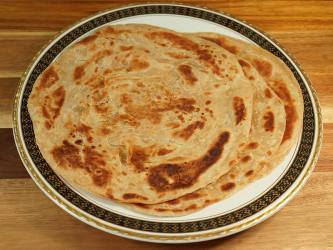Paratha

Paratha is a flatbread that originated in the Indian Subcontinent. It is
still quite prevalent throughout the area. Parantha is an amalgamation of
the words parat and atta which literally means layers of cooked dough. In
Burma, it is known as palata, while it is known as farata in Mauritius and
the Maldives. However, in areas of the Punjabi region, it is referred to as
prontha or parontay.
It is one of the most popular unleavened flat breads in the northern part of
the Indian subcontinent and is made by pan frying whole wheat dough on a
tava. The parantha dough usually contains ghee or cooking oil which is also
layered on the freshly prepared paratha. Paranthas are usually stuffed with
boiled potatoes (as in aloo ka parantha), leaf vegetables, radishes,
cauliflower, and/or paneer (Cottage-cheese).
A parantha (especially a stuffed one) can be eaten simply with a pat of
butter spread on top, with chutney, pickles, and yogurt, or with meat or
vegetable curries. Some roll the parantha into a tube and eat it with tea,
often dipping the parantha.
The parantha can be round, heptagonal, square, or triangular. When it is
round, the stuffing is mixed with the kneaded flour, and the parantha is
prepared in the same way as roti, but in the latter two forms, the peda
(ball of kneaded flour) is flattened into a circle, the stuffing is kept in
the middle, and the flatbread is closed around the stuffing like an
envelope. The latter two also vary in that they have discernible soft
layers, with one "opening" to the crispier shell layers.
History and Popularity
The Paratha is an important part of a traditional South Asian breakfast.
Traditionally, it is made using ghee but oil is also used. Some people may
even bake it in the oven for health reasons. Usually the paratha is eaten
with dollops of white butter on top of it. Sides which go very well with
paratha are curd, fried egg, omelette, Qeema (Ground beef cooked with
vegetable and spices), Nihari (a beef dish), zeera aloo (potatoes lightly
fried with cumin seeds), daal, and raita as part of a breakfast meal. It may
be stuffed with potatoes, paneer, onions, qeema or chili peppers.
Some sources claim that Parantha originated from ancient Vedic times. The
word paratha originated from the Vedic Sanskrit word pu-ro-dhaa-sham (purodhasha).
Purodhasha's are offered to the fire god during Yajna, Yagna or Homa
ceremonies. Vedic purodhashas are usually stuffed with ingredients like
powdered lentils and chopped vegetables. Purodhasham for Indra Purodhasham
is an unleavened bread.
Ready Made Varieties
The process of layering the "skins" of dough in a parantha can make
preparation a difficult process. This, mixed with the popularity of this
flatbread has opened the market to several ranges of frozen paratha –
especially in Western markets where consumers seek the authenticity, but
lack the time required to make a parantha from scratch. Ready to cook
parantha may also be purchased. These preparations offer one-step
preparation and save time. Some of the ready-to-cook products in the market
are just the stuffings for making the stuffed paranthas.
Sources: Wikipedia
undo ...back